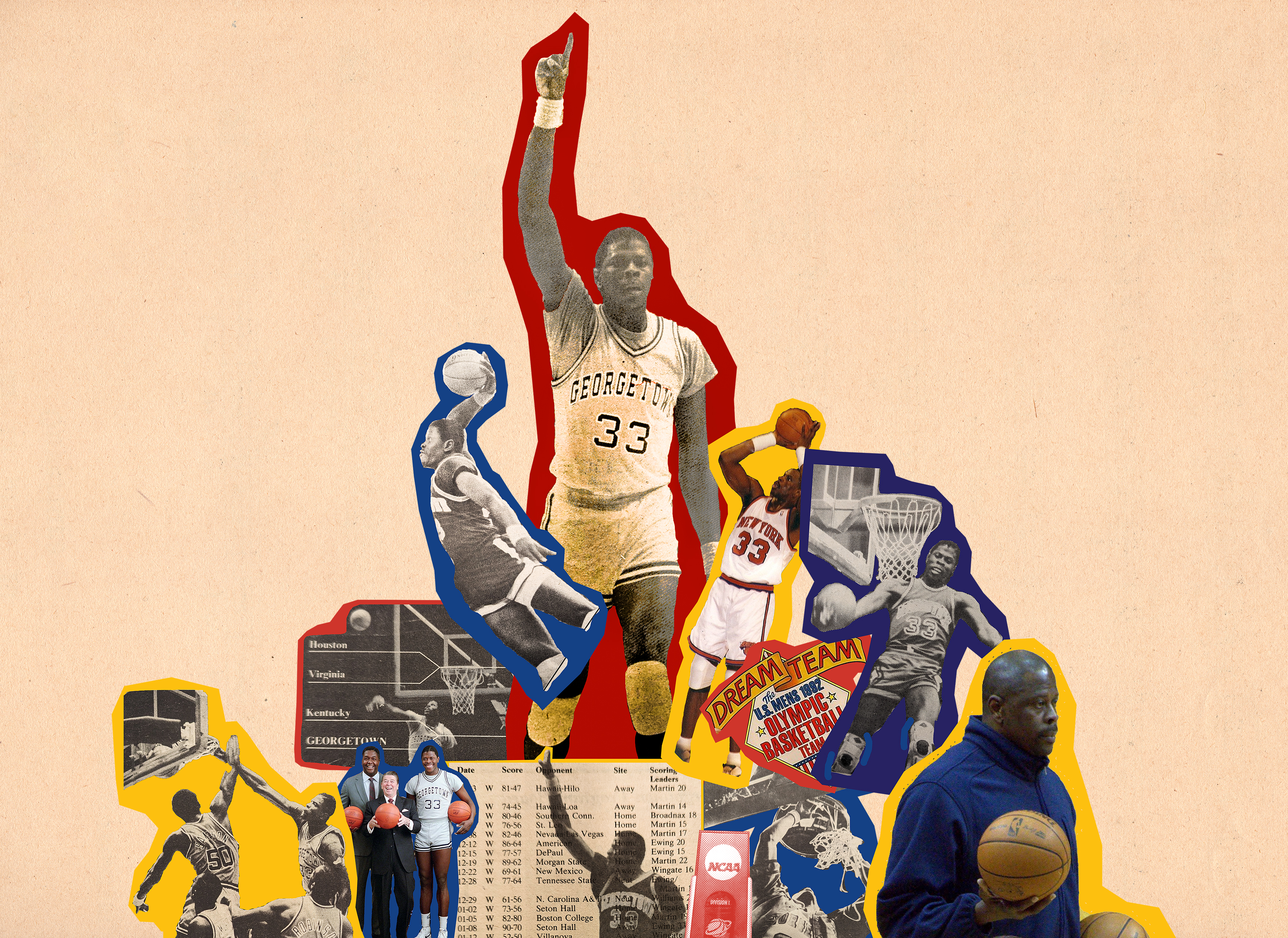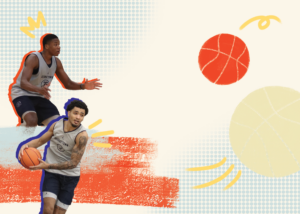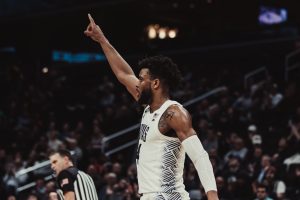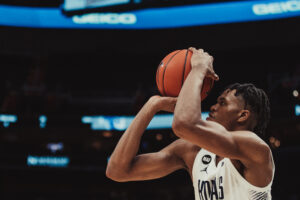There’s nothing worse in sports than being called a loser. Once you’re flagged as someone who can’t win, it follows you like a pungent smell. The stench of purported failure permeates throughout a career. You’re no longer a star, a player, a person; you’re a punchline. The label can linger even after championship success—Peyton Manning, anyone?
The label of “loser” is unfair, often lacking nuance or context. And in all of sports, there is no better example of a label misrepresenting a player than the Ewing theory. The Ewing theory, popularized by former ESPN columnist Bill Simmons, is simple: A star athlete that receives a large amount of media attention and fan interest—but, crucially, never leads his teams to any meaningful success—leaves their team. The team then exceeds expectations without the player. The theory, he explains, “was created in the mid-’90s by Dave Cirilli, a friend of mine who was convinced that Patrick Ewing’s teams (both at Georgetown and with New York) inexplicably played better when Ewing was either injured or missing extended stretches because of foul trouble.” Simmons currently hosts a podcast that is top-five in the country in the sports category and has turned the phrase “Ewing theory” into a regular part of the modern sports lexicon. It has forever altered Ewing’s legacy. This is why people think of that 1999 Knicks team as a team that reached the Finals and was better without him.
It was Game 5 of the first-round playoff series between the top-seeded Miami Heat and the eighth-seeded New York Knicks. The series was tied at two games apiece, and because this is 1999, the series was best-of-five. That means an elimination game in Miami. The game is best remembered for shooting guard Allan Houston’s rim-bouncing buzzer-beater to win the series for New York, but Knicks center Ewing’s effort cannot be forgotten.
Ewing entered the 1998-99 season still recovering from surgery to repair a right wrist injury that he suffered the year prior after getting fouled while attempting a dunk. He had landed awkwardly with all of his weight on his shooting hand, suffering torn ligaments, a dislocated bone, and other fractures. It looked like he had been in a car crash—which makes sense since the injuries to his hand were common in vehicular accidents. A year later, the 36-year-old franchise center had to battle Achilles tendinitis all season. But this was the playoffs, and this was Eastern Conference basketball in the ’90s, which meant the game would be a war of the big men. Ewing faced off against fellow Georgetown alum Alonzo Mourning, a 28-year-old in the prime of his career who had just been named NBA Defensive Player of the Year for that season.
Playing on one good leg, Ewing led New York with 22 points and 11 boards in a 78-77 victory. But the most impressive stat was that he led the Knicks in minutes played. There are 48 minutes in an NBA game, and the “Hoya Destroya” stayed on the floor for 40 minutes despite the searing pain in his near-shredded Achilles. The Knicks reached the Eastern Conference finals, one series away from the NBA championship, another shot for Ewing to finally get a taste of championship glory at the professional level.
But in Game 2 against the Indiana Pacers, Ewing’s Achilles finally gave out during warm-ups. In 2019, Kevin Durant suffered the same injury in the NBA Finals and had to be immediately helped to the locker room. Ewing, nearly two decades prior, decided to play on his torn Achilles tendon anyway, logging 25 minutes and scoring 10 points. Ewing would not touch the court the rest of the playoffs, his torn Achilles resigning him to watch along in street clothes like any other fan. The Knicks reached the Finals without him but were brushed aside by a rising dynasty in the San Antonio Spurs. Yet despite Ewing’s heart and effort, many think the Knicks reached the Finals in spite of Ewing’s performances, not because of them.
But let’s make one thing clear: Ewing is a winner, plain and simple. As a freshman at Georgetown in 1982, he led the Hoyas to a 30-7 record and reached the national championship game. Then, as a junior, he led Georgetown to a 34-3 record and capped off the season by winning the only national championship in school history, defeating the University of Houston’s “Phi Slamma Jamma” team led by Hakeem Olajuwon in the 1985 final. In his final year on the Hilltop, the Hoyas went 35-3 and reached another national championship game, their third in four years. Over the course of his college career, Ewing played in 143 of 144 games, was a three-time All-American, and won the 1985 Naismith College Player of the Year award. Before Ewing got to D.C., Georgetown had only made it past the first round of the NCAA tournament twice. Since he concluded his playing career as a Hoya, they haven’t reached a national championship, the high-water mark being a lone Final Four appearance in 2007. Outside of Ewing’s time as a player, Georgetown has never won more than 30 games in a season.
Ewing was an ironman, someone who missed only one game his entire collegiate career and almost single-handedly turned Georgetown into a national powerhouse. Neither of those two facts fits the Ewing theory of a failure.
In the pros, the theory still falls short. In his first decade as a Knick, Ewing missed only 10 regular season games. New York’s 60-win campaign during the 1992-93 season is tied for the most wins in franchise history, and their Finals appearance in 1994 was their first appearance in the championship round in 20 years. In 1999, their most recent Finals appearance, Ewing’s Knicks were 8-3 while he was on the court. Once he went down for good following his Achilles tear, the Knicks went 4-5. In the 2000 offseason, after the Knicks reached the Eastern Conference finals for a second consecutive season, the Knicks traded away the team’s greatest player of the last 50 years. If the Ewing theory was correct, the Knicks should’ve rebounded to great success, right? Well, throughout Ewing’s tenure with the Knicks, they qualified for 13 straight postseasons and won 18 playoff series, reaching the Eastern Conference finals four times and the NBA Finals twice. Since he was traded in 2000, the Knicks have reached the playoffs a total of six times and only won a single playoff series. They have no Eastern Conference finals appearances and no NBA Finals appearances.
So, as a player, Ewing doesn’t fit the Ewing theory at all. His coaching tenure, though, hasn’t helped his case to escape the label as the world’s greatest loser. His modern relevance on basketball Twitter is the latest stat about Georgetown’s continued misadventures on the court, whether it’s some new record-long losing streak or a clip of the ball being batted around like a fourth-grade pickup game at recess against Northwestern.
During a recent game against St. John’s, Ewing’s mic’d up address in the huddle to players reflected the disparity between his playing experience and coaching skills. He lit into the players for their effort, saying, “Do y’all wanna play? We’re acting like we don’t. Everything they’re doing—everything tougher than us, more aggressive than us. You’re acting like y’all are still asleep. Wake up!” Ewing, who played through countless injuries and battled in every game, can now only watch from the sidelines and plead for his players to turn up the effort. He knows what it feels like to play through injury. He knows about playing hard when tired. He expects the same from his players, but they aren’t performing the way that he once did.
In his final game as a Knick, the series-ending Game 6 loss to the Pacers in the 2000 Eastern Conference finals, Ewing had a new injury that aimed to sideline the superstar: tendinitis in his right foot. He had gutted through the first two rounds of the playoffs, which included another brutal matchup with the Miami Heat—a slog of a series that stretched out to seven games as the ailing Ewing defeated the younger Mourning once again. Against the Pacers—in front of a raucous home crowd in Madison Square Garden that was buoyed by Ewing’s guarantee of victory the day before in the papers—Ewing labored through 37 minutes on the court, managing one last double-double with 18 points and 12 rebounds. It wasn’t enough. The Pacers ran the Knicks off their home court, winning 93-80 in a game that was further apart than the final scoreline suggests. Walking off the court, a team representative yelled after him.
“You’re still the man,” he shouted at Ewing.
Ewing responded in the negative, but the man wasn’t fazed.
“You’ll still get your ring,” the man said.
“I hope so,” Ewing said with a smile.
He never did get his championship ring in New York, or anywhere else in the NBA. He didn’t get the storybook ending that would’ve saved him from all the “what-ifs” and relitigations of his NBA career, that would’ve saved him from the labels of “loser.” Even so, that shouldn’t make him a punching bag. He was a giant in an era of giants, an ironman back when players didn’t take games off. He is still arguably the greatest player in Knicks history, and a piece of jewelry shouldn’t be required for his greatness on the court to be recognized instead of ridiculed. He was a winner but not a champion. And just because he never won a championship doesn’t mean he’s not a winner.






“ In his first decade as a Knick, Ewing missed only 10 regular season games.”.
Sorry to nitpick, but didn’t he miss a lot more than 10 in his 1st 2 seasons with the Knicks?
Lol… Who Cares?
Captain Ewing Is A Legend. He Was A Champion In Georgetown And Definitely Was A Champion And A Member Of The Hall Of Fame By Leading New York KnickerBockers To Thirteen Consecutive Playoffs. In Fact, He Leads All The Knicks’ Players In All (Points, Rebounds, Steals, Assists And All Stars) Career Categories.
Captain Ewing Was A Giant In New York And Led His Team To Two NBA Finals In 1994 And 1999. He Deserves Respect And Admiration. It Is Easy To Criticize Players But When Criticizing You Should Compare His Accomplishments With Other Players And Realize The Greatness He Brought To New York During His Time As A Member Of The NY Knicks.
By ChampionShip Sports888